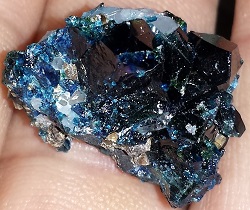A- |
B- |
C- |
D- |
E- |
F- |
G- |
H- |
I- |
J- |
K- |
L- |
M- |
N- |
O- |
P- |
Q- |
R- |
S- |
T- |
U- |
V- |
W- |
X- |
Y- |
Z |
LAZULITE:PHYSICAL CHARACTERISTICS:Color is dark azure-blue to a bright indigo blue or even a pale sky blue. Luster is vitreous to dull. Transparency: Specimens are translucent to less commonly transparent. Crystal System: Monoclinic; 2/m Crystal Habits include a dipyramidal form that comes close to looking like a distorted octahedron, usually flattened to the point of being a tabular crystal. Also granular and massive. Cleavage is distinct in one direction. Fracture is uneven. Hardness is 5.5 - 6. Specific Gravity is approximately 3.1 (average for translucent minerals) Streak is pale blue to white. Other characteristics: Clear gemmy crystals show strong pleochroism (yellowish, clear, blue) and crystals are only slightly soluble in warm hydrochloric acid. Associated Minerals are quartz, rutile, kyanite, andalusite, garnets, muscovite, corundum, wardite, brazilianite and siderite. Notable Occurrences: Western Austria; Zermatt, Switzerland; Minas Gerias, Brazil; Lincoln Co., Georgia; Inyo Co., California and Yukon Territory, Canada. Best Field Indicators: color, poor reaction to acids, crystal habit, associations and localities. Lazulite is a relatively rare mineral that gets easily confused with other, more well known, minerals. Not only does it sound like the silicate mineral lazurite, it looks like it too! Well, at least it has very similar color to lazulite as well as the carbonate, azurite. The beautiful azure-blue color that is seen in all three of these minerals makes them very desirable as ornamental stones. Azurite is reactive to acids and lazurite forms infrequent and different crystals than lazulite. Lazulite is in a solid solution series with the mineral scorzalite. A solid solution series is a set of two or more minerals that have a couple of elements that substitute freely for each other. The lazulite-scorzalite series ranges from the magnesium rich lazulite to the iron rich scorzalite. The rarer scorzalite does not differ appreciably, except that it tends to be darker, less transparent and denser than lazulite. Lazulite is named from an Arabic word for heaven in allusion to its sky blue color. Crystals are more common than massive forms, but localities with gem grade crystals are scattered and scarce. The crystals can be well shaped and show a nice monoclinic dipyramidal to tabular form. Lazulite although most crystals are dull, some exceptional specimens can be quite spectacular. |

